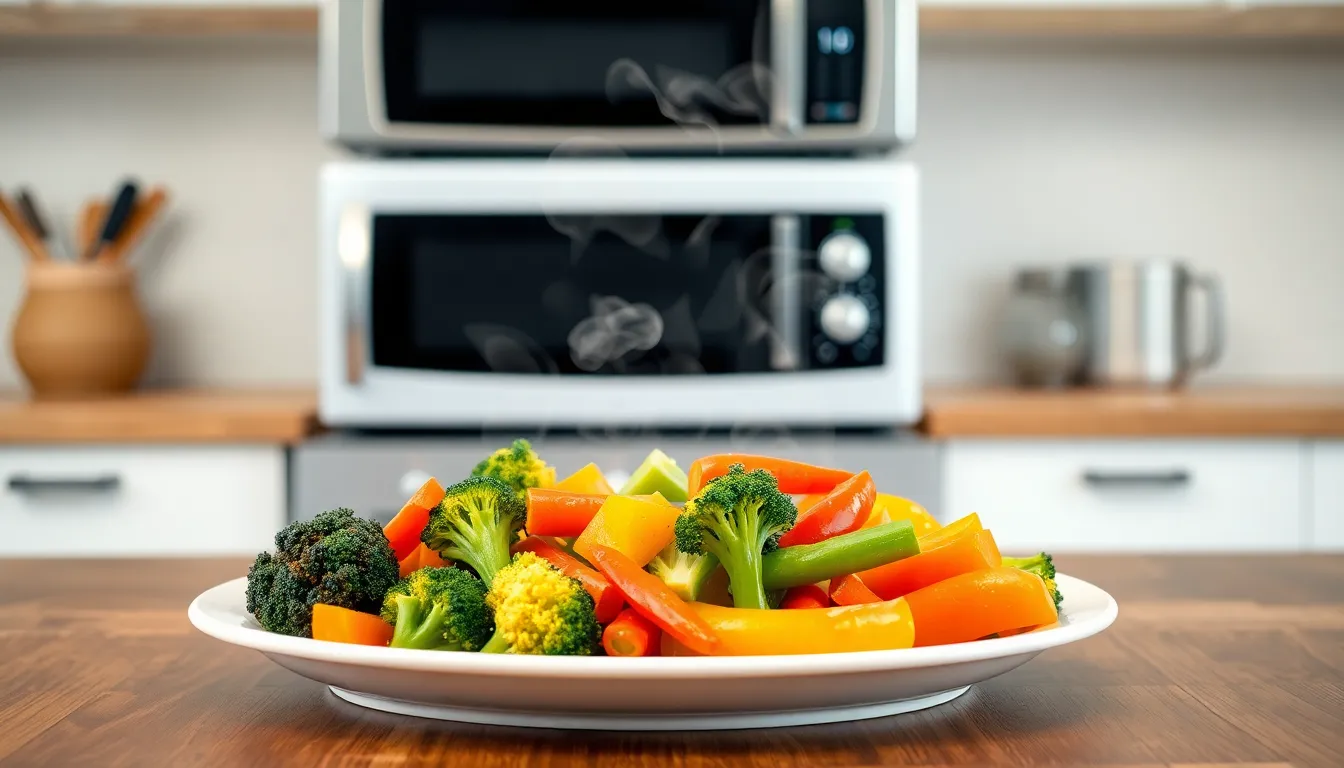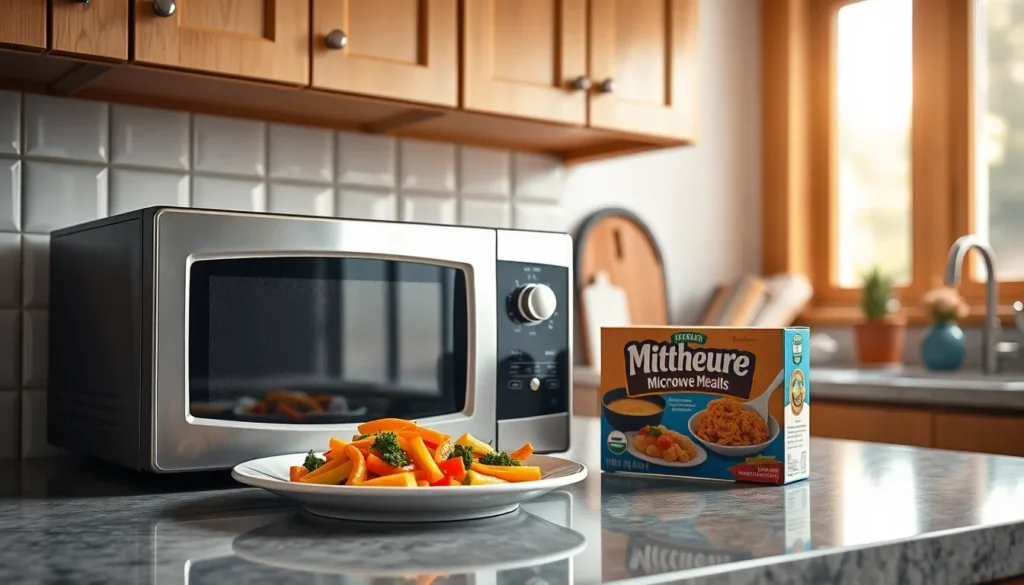Table of Contents
ToggleIn today’s fast-paced world, microwave meals have become the go-to solution for many busy individuals. After all, who doesn’t love the convenience of a piping hot dinner in just a few minutes? But as they pop that plastic-wrapped dinner into the microwave, they might wonder: is this culinary shortcut a blessing or a curse?
Overview of Microwave Cooking
Microwave cooking uses electromagnetic radiation to heat food quickly. This method works by agitating water molecules in the food, generating heat and cooking it from the inside out. Contemporary kitchens frequently feature microwaves due to their convenience.
Individuals often rely on microwaves for reheating and preparing meals. Studies show that about 90% of American households possess a microwave, highlighting its popularity. The majority of modern frozen dinners are designed for microwave preparation.
Nutritional quality varies among microwave meals. Pre-packaged foods can contain high levels of sodium and preservatives. Conversely, fresh vegetables cooked in a microwave can retain more nutrients compared to boiling them.
Cooking times and temperatures significantly impact food quality. Overcooking can lead to nutrient loss and undesirable textures. Heating food in shorter bursts allows for better temperature control and optimal taste.
Microwaving certain foods produces specific results. For instance, popcorn and frozen meals benefit from microwave cooking due to their design. Understanding appropriate cooking times for different types of foods enhances overall enjoyment.
Safety considerations are essential with microwave use. Using microwave-safe containers prevents leaching of harmful substances into food. Additionally, ensuring even heat distribution minimizes risks associated with cold spots that might harbor bacteria.
Debates about microwave safety arise, yet research supports its safety when used properly. Studies have consistently shown that microwave cooking does not alter food’s nutritional profile significantly. Continuing to explore the potential impact of microwaving on health encourages informed choices.
Nutritional Impact of Microwave Food

Microwave cooking can influence the nutritional quality of meals significantly. Understanding this impact provides valuable insights for consumers making dietary choices.
Vitamins and Minerals Retention
Microwave cooking often preserves vitamins and minerals better than traditional methods. Fresh vegetables cooked in microwaves retain water-soluble nutrients like vitamin C and B vitamins. Studies indicate quick cooking times prevent nutrient loss, enhancing the overall quality of the food. Additionally, steaming in a microwave minimizes exposure to heat, which helps keep nutrients intact. Though some nutrient degradation occurs, the retention rates remain significantly higher when compared to prolonged cooking methods.
Comparison with Other Cooking Methods
The comparison of microwave cooking with other methods reveals distinct advantages. Traditional boiling tends to leach nutrients, particularly in vegetables. On the other hand, grilling and baking can result in higher nutrient loss due to exposure to high temperatures for extended periods. Frying introduces unhealthy fats and reduces nutrient content. By contrast, microwaving offers a nutrient-friendly alternative that can still deliver satisfying meals, especially when followed by proper cooking times and techniques.
Health Concerns Related to Microwave Food
Microwave meals offer convenience, but health concerns arise regarding their safety and nutritional value.
Chemical Leaching from Containers
Using certain plastic containers in microwaves can lead to chemical leaching. Chemicals such as BPA and phthalates may migrate into food when heated. Selecting microwave-safe containers is essential to minimize health risks. Glass and ceramic options typically pose fewer risks than plastics. Research indicates that long-term exposure to these chemicals could harm human health, raising concerns among experts. It’s crucial to check for labels indicating that containers are microwave-safe before use. Awareness of food type and container material supports safer microwave meal preparation.
Risks of Uneven Heating
Microwaves can heat food unevenly, which may leave cold spots. Cold areas in food can harbor harmful bacteria, potentially leading to foodborne illnesses. Stirring and rotating food during microwaving can help distribute heat evenly. Experts recommend using a food thermometer to ensure a safe internal temperature, especially for meats and poultry. Cooking times vary depending on food type and portion size, highlighting the importance of following guidelines. Taking these precautions enhances safety and improves food quality during microwave cooking.
Benefits of Microwave Food Preparation
Microwave food preparation offers numerous advantages, particularly for those with busy lifestyles. Time and convenience are major factors that attract individuals to this method of cooking.
Time Efficiency
Cooking food in a microwave greatly reduces preparation times. Meals that typically take hours to cook in an oven can be completed in just minutes. Most microwave meals require minimal effort, freeing up time for other activities. The ability to reheat leftovers quickly adds to the time-saving aspects, making it ideal for hectic schedules. Busy families, students, and professionals find microwave cooking an efficient solution for quick meal fixes. Consequently, this method supports healthier eating habits by making home-cooked meals more attainable.
Convenience and Accessibility
Microwaves are common appliances in nearly 90% of American households, making them easily accessible. Various frozen meals and ready-to-eat options cater to different dietary preferences, such as vegetarian and gluten-free. Preparing microwave meals requires minimal cleanup, unlike other cooking methods that may involve multiple pots and pans. Additionally, microwaves are user-friendly. Individuals can follow simple instructions, making meal preparation stress-free. As a result, this convenience promotes cooking at home instead of resorting to takeout or fast food options, enhancing overall dietary quality.
Microwave food can be a practical solution for those balancing busy lifestyles. While concerns about nutritional quality and safety exist it’s essential to approach microwave meals with informed choices. By selecting healthier options and using appropriate cooking techniques, individuals can enjoy the convenience of microwave cooking without compromising their health.
Understanding the benefits of microwaving fresh ingredients can enhance both flavor and nutrition. With careful attention to cooking times and container safety, microwave meals can serve as a valuable part of a balanced diet. Ultimately, it’s about making smart decisions that align with personal health goals while embracing the efficiency that microwaves offer.





